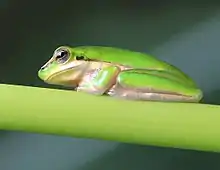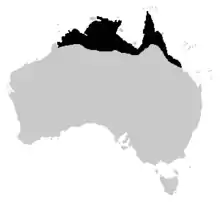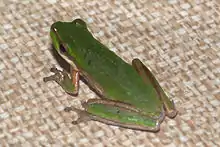Northern dwarf tree frog
The northern dwarf tree frog (Litoria bicolor) is a small species of tree frog native to northern Australia, from the Kimberly region of Western Australia to Bowen, Queensland, and Aru Islands of Indonesia. These small frogs are also commonly called sedge frogs. The population occurring in Indonesia may not be L. bicolor, and research on call structure or genetics is needed to confirm its taxonomic status.
| Northern dwarf tree frog | |
|---|---|
 | |
| Scientific classification | |
| Kingdom: | Animalia |
| Phylum: | Chordata |
| Class: | Amphibia |
| Order: | Anura |
| Family: | Pelodryadidae |
| Genus: | Litoria |
| Species: | L. bicolor |
| Binomial name | |
| Litoria bicolor Gray, 1842 | |
 | |
| Range of the northern dwarf tree frog in Australia. | |
Description

The northern dwarf tree frog is small, slender tree frog growing up to 30 mm in length. The dorsal surface is green and is bordered by a bronze stripe.
Ecology and behaviour
Most abundant in grassland or marshy areas, but also occurs along permanent or semi-permanent streams, billabongs and floodplains. Breeding starts with summer rains and 10-24 eggs are laid on submerged vegetation in temporary pools. Males call from around the breeding site from elevated positions. The call is a "wree-e-eck pippip" with the second part of the call starting before the first part finishes. Tadpole metamorphosis takes 70 to 80 days.
Similar species
The northern dwarf tree frog is a member of the Litoria fallax complex, which includes also includes the eastern dwarf tree frog (L. fallax), Cooloola tree frog (L. cooloolensis) and Olongburra frog (L. olongburensis). All these species are similar in appearance (small, <30 mm and similar body shape) and have a similar call (ratchet-like "wreek"). The northern dwarf tree frog is most similar to the eastern dwarf tree frog. They occur together along the east coast of Queensland. L. bicolor can be distinguished from L. fallax most readily by the presence of a bronze stripe that runs down the flanks and the call. The first phase of the call of L. bicolor is twice as long as that of L. fallax.
References
- Barker, J.; Grigg, G.C.; Tyler,M.J. (1995). A Field Guide to Australian Frogs. Surrey Beatty & Sons.
- Frogs Australia Network - Litoria bicolor - call available here
